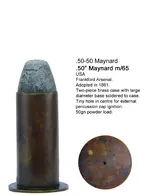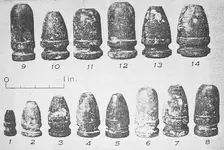- Joined
- Nov 23, 2012
- Messages
- 433
- Reaction score
- 1,419
- Golden Thread
- 0
- Location
- Southwest Idaho
- 🏆 Honorable Mentions:
- 1
- Detector(s) used
- Minelab CTX3030
Minelab E-trac
Minelab Equinox 80
Deus II
- Primary Interest:
- Metal Detecting
I know what my guess is, but it doesn't seem to fit the area where I found it....well, not exactly. It was found at an Indian War era fort (late 1860s - mid 1870s). It appears that the rim has separated from the base so keep that in mind. The bullet diameter is .54 inches. The cartridge base is .55. The cartridge length is 1.2 inches (without the missing rim) and the overall length is 1.9 inches (again, without the missing rim). There weren't many .54 caliber metallic black powders and I'm thinking this is a .54 Ballard. I know they were used in the later part of the Civil War, but have not heard of them used in the Indian Wars. Any thoughts?







